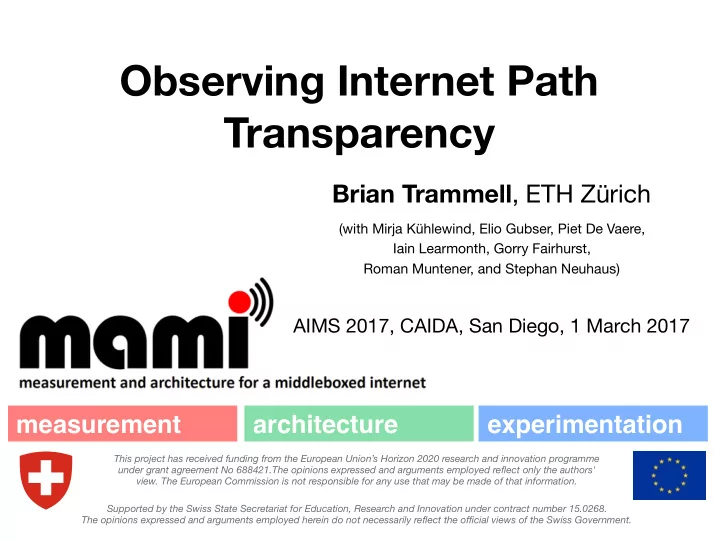

Observing Internet Path Transparency Brian Trammell , ETH Zürich (with Mirja Kühlewind, Elio Gubser, Piet De Vaere, Iain Learmonth, Gorry Fairhurst, Roman Muntener, and Stephan Neuhaus) AIMS 2017, CAIDA, San Diego, 1 March 2017 measurement architecture experimentation This project has received funding from the European Union’s Horizon 2020 research and innovation programme under grant agreement No 688421.The opinions expressed and arguments employed reflect only the authors' view. The European Commission is not responsible for any use that may be made of that information. Supported by the Swiss State Secretariat for Education, Research and Innovation under contract number 15.0268. The opinions expressed and arguments employed herein do not necessarily reflect the official views of the Swiss Government.
measurement Observing Path Transparency: What and Why? • Determine the extent to which transport-layer protocols and features are impaired by accidental and purposeful manipulation in the present Internet • Provide guidance for protocol engineering: which features need a fallback, which can we let fail, which will never work? • Take simple active measurements source X over many paths , infer conditions , source destination compose in space in time source Path Transparency AIMS ’17 2
measurement Active Measurement: Pathspider • Tool 1 for one-sided measurement of many targets from a single source, with simultaneous passive observation of generated packets • Plugins for ECN, TFO, DSCP • Extension support sys config • Connectivity dependency sysctl configurator • Automation 2 of cloud-originated sync test tra ffi c targets worker measurement of public targets 3 target targets worker targets workers queue target info • Multiple-source measurement for output merger data path-dependency inference tra ffi c info [1] https://pathspider.net/ observer [2] https://github.com/mami-project/autospider-salt [3] https://github.com/mami-project/targets Path Transparency AIMS ’17 3
measurement Composition and Analysis: Path Transparency Observatory • Collect observation data as raw output from various tools (including Pathspider) • 1 st stage (raw) analysis converts these to base observation four-tuples: {t, p, c, v} • t: time interval during which observation is valid • p: path designator, a sequence of path elements from observation point or source to target or destination • c: condition observed (within a defined space of conditions) • v: value associated with condition observed • n th stage derives composed observations from base observations Path Transparency AIMS ’17 4
measurement Design Goals: Path Transparency Observatory • Provide comparability, reduction, and visibility to data from different sources through a common schema for path transparency information. • Ensure repeatability by providing provenance, link observations to intermediate and raw data as well as analysis code (by commit reference). • Provide safety for collected data via: • Variable-precision, anonymizable path designators. • IP , prefix, AS, pseudonym-level. • Code reviews of contributed analyzers. • Human review of first stage results. • Provide accessibility with a web front-end for issuing queries as well as “canned” queries for common conditions. Path Transparency AIMS ’17 5
measurement Design: Path Transparency Observatory Analysis Runtime PAPI upload Derived Raw Analyzer Raw Analyzer Analyzer raw raw observations analyzer log measurements metadata (PostgreSQL) (PostgreSQL) (ext4) (PostgreSQL) Analysis Playground PAPI query (jupyter) Web front-end Path Transparency AIMS ’17 6
measurement Lessons Learned: Medium Data Suffices • Initial design: Big Data™ compliant • HDFS for raw data files, Spark for raw analysis, MongoDB for observation and metadata storage, provenance per observation . • Lots of overhead for not much win • Rigid workflow poorly matched to research • Reimplementation: keep it simple (and party like it’s 1999) • Raw data in ext4, raw analysers over streams • PostgreSQL for observations and metadata w/ provenance and derived analysis per observation set . • Human intervention in analysis (required for review anyway). Path Transparency AIMS ’17 7
measurement Lessons Learned: path opacity not so different from censorship/non-neutrality • Measurement of path-dependent ECN connectivity dependence: inferred middlebox interference far from the endpoint. • Automated measurement reduces the noise floor, eliminates transient failure. • What we see: failures much more likely in countries with documented heterogeneous, TCP-interfering censorship. Path Transparency AIMS ’17 8
measurement The Future • Convergence with censorship/neutrality measurement • Definition of condition set in terms of OONI test specifications; integration of Pathspider with OONI. • Transition to access network/mobile measurement • Pay more attention to the path • Now we just look at endpoints, i.e. [src, *, dst] • Add resolution-time AS and traceroute to Pathspider • Explore graph databases for comparison/analysis Path Transparency AIMS ’17 9
Recommend
More recommend